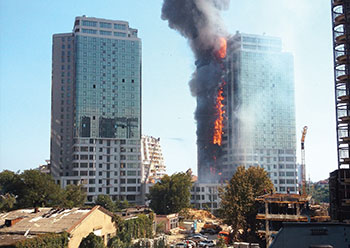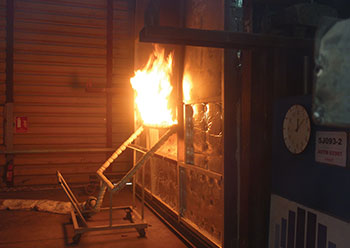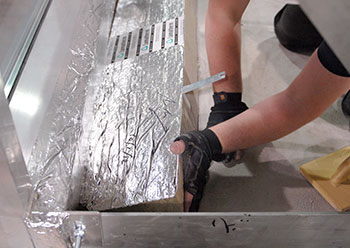
Flames and fire gases in the building attack details of the curtain-wall and associated perimeter fire barrier materials.
Compartmentation is need of the hour
MAYANK SHARMA* focuses on the importance of effective compartmentation to safeguard lives and prevent fire spread in buildings in the event of a fire, while highlighting the need to test the fire performance of spandrel panels in aluminium-framed curtain-walls.
01 September 2020
The risk of fire spread through articulated elements of the façade or vertically around the façade via the mechanism of flame leap, poses new concerns for the newest class of super high-rise structures.
These concerns revolve around the issues of fire department response capabilities, the reliability of sprinkler systems and associated water supplies and the characteristics of the building and its occupants.
More importantly, as architects develop new and leading-edge creative curtain-wall designs, it becomes more critical to consider the risk factors that can impact the building’s overall level of fire safety and discuss what building system and features can factor into an analysis to validate a specific curtain-wall design detail.
Curtain-walls are a relatively complex combination of components that include aluminium frames, vision glass, metal back pans; insulation; gaskets; and anchors or connectors of steel or aluminium. Given a fully developed fire exposure in a room or space bordered by a building’s curtain-wall system, it can be expected that vision glass failure will occur within minutes. Once the failure occurs, the flames extend to the exterior and the various curtain-wall components and the perimeter fire system are then subjected to thermal forces and degradation, which can result in fire spread to the floor above.
 |
|
Fire performance testing of panels to ASTM standards. |
Fires in high-rise buildings generate large quantities of smoke that tend to spread vertically throughout the building, even if the fire is contained to one room. Smoke travels at up to 130 m every minute and whilst most people can easily move at this rate in normal circumstances, the majority of survivors of fires have stated that smoke restricted their ability to see to no more than 4 m.
Flames and fire gases in the building attack the interior surfaces and details of the curtain-wall and associated perimeter fire barrier materials.
Outside, flames and hot gases projecting from the fire-broken glazing directly strike on the external surface of the curtain-wall. These flames radiate heat to and through glazed surfaces.
It is evident that exterior building detailing, articulations incorporated as elements of the façade and structural floor changes/extension can impact the flame projection and associated radiation heat exposure to the façade.
Effective compartmentation is a major measure to protect life safety in buildings. If properly designed, installed, inspected, and maintained, effective compartmentation components provide reliable protection to life and assets.
Perimeter fire barrier
Firestopping is part of effective compartmentation, which involves the building of fire, smoke, and other resistance-rated assemblies into “boxes” in buildings to keep fire from spreading from the room of origin to other parts of a building. Compartments are formed when an area or fire walls separate one space from another, allowing the collapse of one side without the other sides being structurally affected. They are also formed when resistance-rated walls are constructed in corridors, when resistance-rated floors are built for floor-to-floor protection, and when spacing between buildings is added to protect against fire spreading from building to building.
Perimeter barrier firestops seal the linear gap between the edge of the compartment floor slab and external curtain-wall. Due to project designs and site tolerances, this linear gap can be variable, so the firestop system used needs to have a degree of ‘dynamic’ movement capability – compression and recovery – in order to accommodate serviceability movement.
What is critical is that the firestop system must do this in combination with the primary functional requirement, which is to maintain continuity of fire resistance between the compartment floor and the external wall. The installed firestop system needs to match the same period of fire resistance as the compartment floor.
All firestop systems need to be tested to two criteria: integrity and insulation (EI).
 |
|
Slab edge fire stop ... firestopping is part of effective compartmentation. |
Integrity (E) refers to the ability of the system to prevent the passage of flame, smoke and combustible gases either through, around the material or through joints in an assembly; while insulation (I) refers to a measure of the increase in conducted heat transferred from the exposed to the unexposed surfaces of a 180-degrees-C rise above ambient.
These two criteria are critical in the development of curtain-wall perimeter firestop products. The most effective products combine a number of material features – density, thickness, resin content, fibre structure and controlled compression – which together determine the resistance properties.
When looking at the integrity (E) criteria, the material chosen must be impervious to the transfer of flame and gases, easy to install with minimal site management and accommodate all real-world requirements at interfaces, joints and details.
Whilst specifying the correct product is vital, the quality of installation is equally as important. Contractors installing life-saving measures such as perimeter barriers and firestops must have adequate training on the particular manufacturer’s products and be qualified to install it in the first place. When it comes to saving lives and protecting businesses and property, a well designed and installed system can make the difference.
Spandrel performance
The construction of the spandrel can be an important factor in the performance of the perimeter fire barrier system. Typical aluminium-framed curtain-walls using spandrel glass require that the glass be appropriately insulated using mineral wool rather than combustible insulation that will melt. Additionally, the aluminium mullions require insulation protection; otherwise, the aluminium frame will melt and will no longer support the wall system. These measures will help keep the glass spandrel panel and any associated fire barrier system intact. When subjected to fire heat, metal curtain-wall panels or metal back pans, may wrap or distort, allowing gaps to develop at the perimeter fire barrier system, which might result in the failure of the compartment.
As the performance of the perimeter fire barrier is highly dependent on the performance of spandrel panel/curtain wall, it becomes essential to test/verify the fire performance of the spandrel panel.
There are multiple standards available within both ASTM and EN standards to test the performance of the external spandrel. One recently developed standard is ASTM E2874-19, Standard Test Method for Determining the Fire-Test Response Characteristics of a Building Spandrel-Panel Assembly Due to External Spread of Fire.
This test method provides for the following measurements and evaluations:
- The ability of the spandrel-panel assembly to resist the passage of flames or hot gases sufficient to ignite a cotton pad, or be visible to an observer;
- Transmission of heat through, and above, the spandrel-panel assembly using heat flux and unexposed surface temperature measurements.
As described in the testing method’s “scope” section, the new standard evaluates the fire-test response of a spandrel-panel assembly spanning the intersection of a floor assembly. It assesses the spandrel-panel assembly’s ability to impede the spread of fire to a room’s interior or the floor immediately above it via fire spread from the exterior of a building. The testing method simulates a fire in a post-flashover condition in a compartment vented to the exterior via a window opening.
Top questions to ask when purchasing firestop systems that have insulation as a component are:
- What tested and listed systems is the insulation tested in?
- Is the spandrel rating/performance part of the tested and listed system?
- Is the insulation specified by name in that tested and listed system?
- Show the system!
Then visit the certification database.
Firestopping is a matter of matching the tested and listed system with conditions as they exist in the field exactly. There are no ‘construction tolerances’, ‘make it fit’ or other variations allowed, unless specified in the tested and listed system. Once a contractor understands that philosophy, makes it part of the corporate culture, from office to field, then successful firestopping projects can take place.
* Mayank Sharma is Technical Specification Manager at Siderise Insulation (a UK-headquartered provider of innovative insulation solutions for fire, acoustic, and thermal applications), overseeing the Middle East and South Asian Market.


